Nuno Felting My First Simple Shawl

Working with wool opens so many amazing design possibilities! Just imagine laying out fibres to create a unique new ‘fabric’! Nuno Felting my first Simple Shawl was surprisingly quick & so much fun. Let me share the magic with you…

What Is Nuno Felting?
This method involves the wet felting technique to process natural fibres (most often wool roving) onto a layer of fabric (silk chiffon, cotton gauze, open weave fabric) to create a new textured material. I previously used a dry-felting technique using barbed needles. For my first beginner experience with Nuno Felting I am creating a shawl/scarf using a very light open weave silk scarf. The base fabric needs to allow the fibres of the wool to be able to grab onto and tangle through it. This is achieved with a wet felting process that uses agitation to make the fibres tangle and become felted. Animal hair fibres have scales on the shafts that can open and entangle together.

Adapting Nuno Felting Tools:
Certain tools can help to make this felting process a bit easier. Some type of vibration makes the fibres rub against each other so that the tiny scales start to hook into each other. There are many tools available that have some type of bumps on them that make the fibres rub. They may be called a ‘Mool’ or a felting tool.
I found a cheap flat-bottom shower puff handle that I equipped with some stick-on pearl and gem ‘bumps’.

I realize this home-made felting tool is not as pretty as a wooden one but it does work quite well. If you plan to make a lot of wet-felting projects you can certainly make your own tools. Rolling pins with ridges also create that agitation.
As a work surface you can use bubble wrap (try to up-cycle from packaging) as it also allows the magical agitation and needed friction. Other textured mats like a nubbly rug or solar pool blanket also work well.
A fine weave netting or fabric is used to help flatten down fibres at the start.

The Nuno Felting Supplies:
The simplest of supplies is a merino wool roving. Wool Roving is available as un-spun fibre in a variety of colours. Other fibres can also be added for an accent but natural animal fibres are usually needed to be able to felt. Such other felting fibres can include: camel, llama, alpaca, Mohair goat, Cashmere goat, yak, and even rabbit fur. Some fibre types such as silk do not felt on their own that well but will get entangled with the wool to become an accent fibre. I also used a loosely spun wool that I can coaxed into small wisps of shapes.
My base fabric is a pre-hemmed sheer silk scarf. The felting process will make the final size smaller as the fibres pull and shrink together.
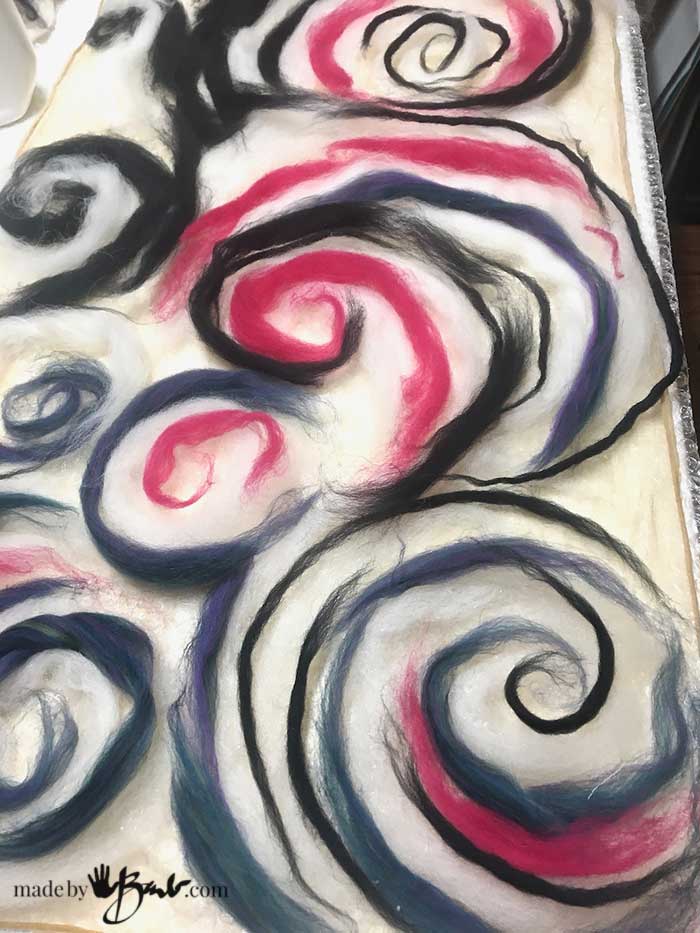
Laying the Fibres:
Lay out enough bubble wrap (bubbles up) to fit the base fabric. Pull out wafts of the roving and carefully place them on the silk in the shapes that you like. My intention is to have a fairly light Nuno felting. I also wanted to see how the silk will end up so I did not completely cover the entire surface of the silk scarf. There are actually a lot of variations that can be made in the design element so that you create something that is completely unique.
It is important to understand that any areas without a layer of wool will eventually pucker as the wool shrinks; however that is part of the charm of the design process.
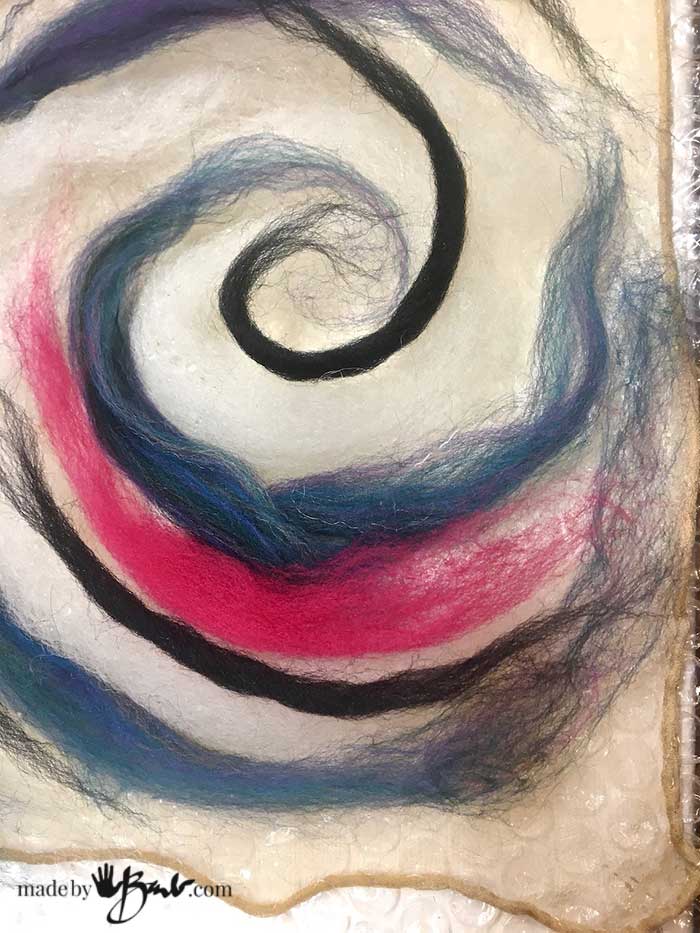
Even though the amount of wool fibers used here is minimal the base fabric will ensure that it all stays together. For this reason I think the possibilities are endless! If you want to add certain particular shapes you can make some partially felted fabric called Prefelts and cut them to add to the design. As an artist this opens up so many creative directions.
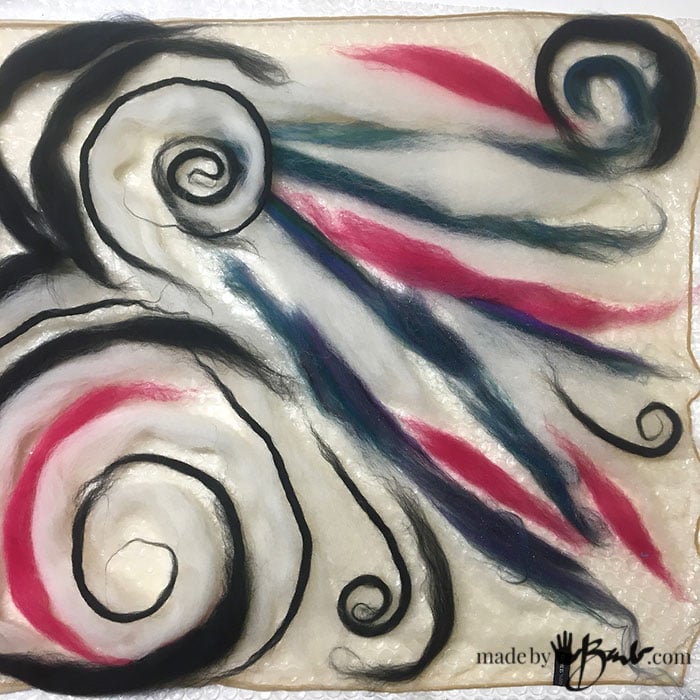
Laying the Wool Design :
If there are sections that have more wool roving applied they will felt more and therefore also shrink more. That will create unique textures and also shape to the shawl. You are in creative control…

Since the placement is only sitting on the surface you can adjust as you like. I was very curious at how the shapes would eventually look when all finished.

Starting the Wet Felting:
The next step is to wet down the fibres. Mix some very hot water with a bit of mild soap. I like to use an olive oil soap as it is very slippery and also mild. You can sprinkle water on the fibres or place a sheer netting (like old curtains) on top to keep the design in place and sprinkle/spray through the netting. Eventually I’ll gather the tools like the rubber bulb sprayer for the wetting stage but a spray bottle does work fine.
Gently smooth out and distribute the moisture through the layers by sliding your hands. It should only be wet enough to allow your hands to slide over the surface, not be flooding and leaking out.

Carefully peel back the netting and cover with bubble wrap (bubble side down).

At this point you can roll it and exercise your forearms or in my case; I used an electric sander. It is a random orbital sander, not a disc sander. Be very cautious about using an electric appliance around water (use a grounded plug like those in the kitchen). The bottom of the sander has no sandpaper and should just be able to slide easily. There should not be puddles of water or wet hands! It works quite quickly so check progress often.
Work gently (pressing too much will lessen the agitation) across the piece in multiple directions.
If you work manually roll the bubble-wrap ‘sandwich’ and roll back and forth from hands to forearm repeatedly. Unroll and re-roll in other direction to further roll.

Check for progress:
Open the layers and see how much the fibre have attached. Gently pull to see if they are firm or need more processing. You will see some fine curliness to the wool fibres as they start attaching to each other, getting tighter and shrinking. When it seems like there are very little stray fibres loose then you can rinse and squeeze out the water.

During the washing further felting happens when it is moves from hot to cold water and back again. This shocking makes the fibres also lock. Throwing the bundle into the bottom of the sink is another way to make the fibres lock. It really does seem like we are ‘beating’ these fibres into submission!
Rubbing the fabric across an old glass wash board will further the felting process, this is called fulling.
Rinse out any soap and squeeze out moisture. You can also use a spin cycle or blotting in towels for excess water.
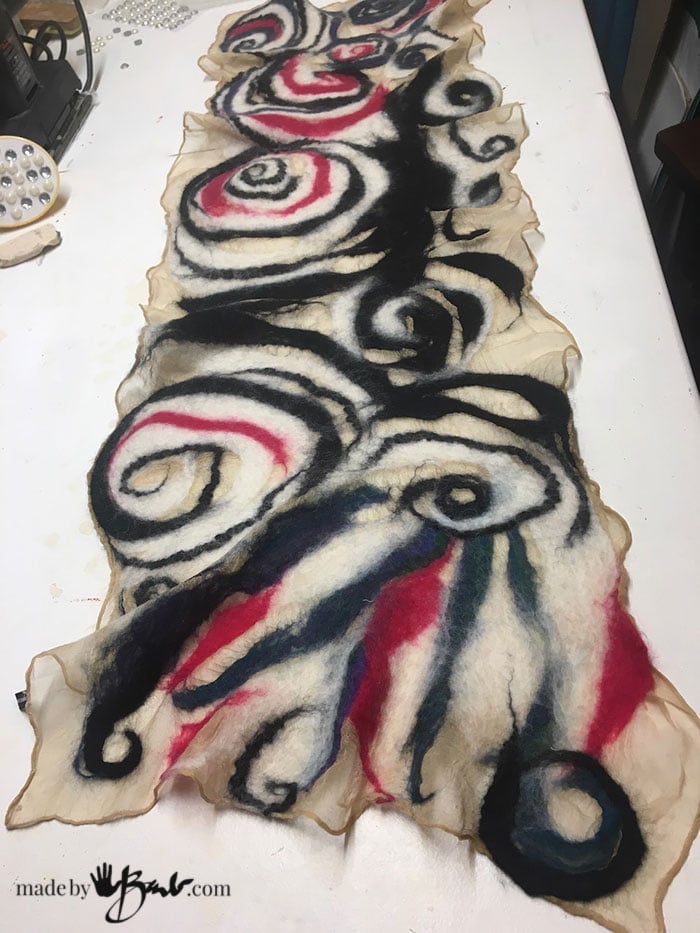
Understanding Shrinkage:
Yes, the nuno felting becomes smaller; it shrinks! How much it shrinks will depend on a few factors. Fine wool will shrink more than coarser wool, thicker application of wool will also shrink more. The more aggressive the felting method used also makes it smaller; even the water temperature can affect it.
During my research I found that Polly Stirling came upon this process back in early 90’s. I love to see how such sculpture and texture can come from this wet felting on a fabric process.

The ‘squiggles’ from the shrunken wool are evident in the shapes of roving. The edges almost seem puckered from the fibres pulling tight together. I do not think a heavier fabric would allow the needed puckering. I also do not think that polyester would work as a base fabric unless it is very loosely woven for the fibres to imbed into.

It is still quite light in weight and super soft. The merino wool works great in this nuno technique.
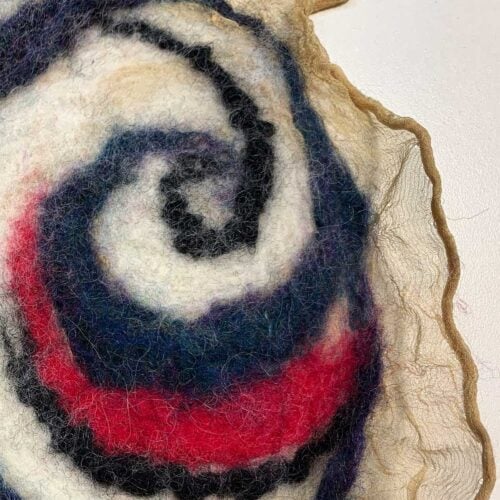
So creative – it turned out so beautiful!
I just love seeing what medium you tackle and put your own spin on. Your mind must always be spinning and pre creating 🙂
Thanks! You are right; I can not keep up with all the ideas I dream up!
I was excited to see this, it gives me the courage to start felting, with an “easy” project…I think this will be fun, you are an inspiration to me…Thank you for sharing your experience with all of us, it is very much appreciated.
I’m happy to inspire you. Every time I look at my collection of roving I dream of holding that soft finished fabric… and all the design options.
Wool is my preferred medium. I’m collecting supplies to nuno felt a piece to be the river in an art piece. Thanks for the timely helpful hints!
That sounds interesting! There are some glossy fibres that would bring a nice detail to the flowing water. Needle Felting would also be an option. Happy making!
Needle felted the clouds …. They look great. You are so right about including other fibers – silk! Collect stuff ‘cause it might be perfect for ????